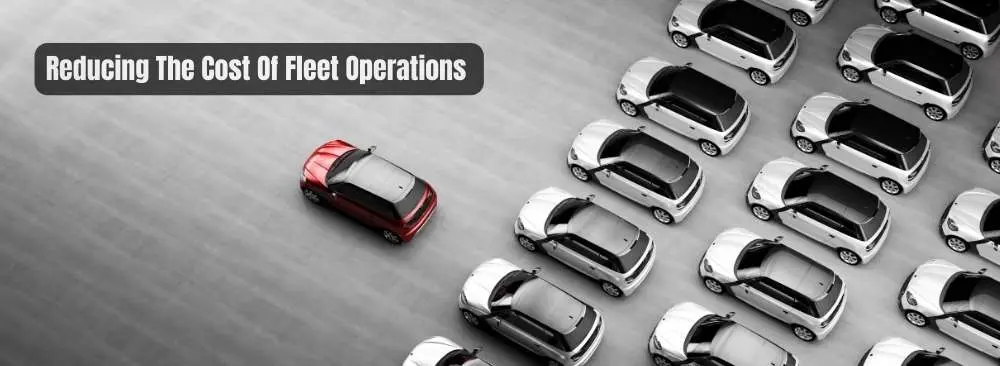Do you want to reduce the costs of your fleet operations? Managing a fleet of vehicles can be complex and costly for businesses of all sizes. Whether you run a delivery service, operate a taxi company, or have a corporate fleet, finding ways to reduce operating costs is crucial for profitability. This article will explore ten easy and effective strategies to reduce fleet operating expenses.

From optimizing maintenance schedules to encouraging fuel-efficient driving habits, these techniques will help your business streamline operations and boost the bottom line.
Key Takeaways
Reduce the Fleet’s Size
Reducing the number of vehicles in any given fleet is the most proven way to reduce overall costs. To achieve this, one can optimize car utilization, implement car-sharing programs, and reassign underutilized vehicles.
Cut Miles Traveled
Unnecessary trips with little business justification occur, driving up vehicle operating costs. Implementing route optimization software, encouraging carpooling, and reducing personal use of company vehicles can help cut miles traveled.
Optimize Maintenance Timelines
Maintaining vehicles accounts for most of the costs in the average fleet, and waiting for cars to break to fix them is a recipe for a huge maintenance bill. Implementing a preventive maintenance program, tracking maintenance expenses, and using predictive analytics can help optimize maintenance timelines.
Fuel-efficient Driving
To guarantee that their assets are functioning as intended, fleet managers must comprehend the fuel economy of each of their vehicles. Implementing a fuel management program, training drivers on fuel-efficient driving habits, and using fuel-efficient cars can help focus on fuel.
Use a Cost Charge-Back System
Many companies lose money simply because their fleet operating costs aren’t visible enough. Implementing a cost charge-back system can help increase visibility and accountability for fleet expenses.
Measure Your Average Trucking Cost Per Mile
Calculating your average trucking cost per mile allows you to pinpoint cost-saving opportunities and maximize profitability. You can identify strategies to minimize expenses and boost earnings by analyzing the average price per mile.
Invest in Fuel-Efficient Models
Investing in vehicles designed to consume less fuel can substantially impact the money your fleet spends on energy in the long run. Opting for fuel-efficient models can effectively decrease fuel costs and save considerable time.
Optimize Fuel Purchases
Optimizing fuel purchases through timing, automated technologies, driver training, and management steps can significantly reduce your fleet’s fuel expenses.
Create/Update Your Fleet Policy
Creating or updating your fleet policy to include vehicle usage, maintenance, and driver behavior guidelines can help reduce expenses and increase accountability.
Consider Driver Behaviors
From risky driving habits to unreported personal use of business vehicles, driver behavior can impact your bottom line tremendously. However, you could significantly reduce your costs using tools like Holman’s Driver Scorecard and Driver Insights to identify and address risky drivers faster, create a safety culture within your organization, and establish efficient reporting policies reinforcing accountability.
Remember, keeping track of all expenses and making data-driven decisions to maximize profitability is essential. Fleet management software allows you to track payments in real-time and calculate the total cost of ownership (TCO).
Formula To Calculate Fleet Operations Cost
The formula to calculate fleet operations cost typically involves considering factors such as fuel, maintenance, insurance, depreciation, and labor costs. Here is a general formula that can be used as a starting point:
Fleet Operations Cost = Fuel Cost + Maintenance Cost + Insurance Cost + Depreciation Cost + Labor Cost
Please note that the formula can vary depending on the specific requirements and characteristics of the fleet. It is advisable to consult with fleet management professionals or use specialized fleet management software to get accurate cost calculations tailored to your specific needs.
Conclusion
Reducing operating costs for your fleet is not just about saving money; it’s about making your operations more efficient and sustainable. By implementing the strategies outlined in this article, you can optimize vehicle usage, maintenance, and fuel efficiency while fostering a culture of responsibility among your drivers.
Remember, data-driven decisions and fleet management software are essential for tracking expenses and maximizing profitability. So, take these steps today to ensure your fleet operates at its most cost-effective level, benefiting your bottom line and the environment.
You might want to check out this article: New vs. Used Car: Which Is A Better Choice In 2024?
FAQ: Cutting Down The Costs Of Fleet Operations
Reducing vehicles lowers costs by optimizing utilization and implementing car-sharing programs.
Implement route optimization software, promote carpooling, and limit personal use of vehicles.
Preventive maintenance and tracking expenses reduce overall maintenance costs.
Implement fuel management, train drivers on fuel-efficient habits, and use efficient vehicles.
It increases visibility and accountability for fleet expenses within your organization.
It helps identify cost-saving opportunities and maximize profitability.
They decrease fuel costs in the long run, benefiting your fleet’s budget.
It significantly reduces your fleet’s fuel expenses through various strategies.
It reduces expenses and increases accountability by setting guidelines.
Tools like Holman’s Driver Scorecard and Driver Insights help identify and address risky behaviors, promoting safety and accountability.
Fleet Related Topics:
How To Manage Your Fleet Budget Effectively And Save Money
Fleet Acquisition Options: Buying New Vs. Used Vehicles Or Leasing
Fleet Sizing And Composition: Best Practices For Your Business
Efficient Fleet Management: Everything You Need To Know
How To Find A Suitable Car Fleet For A Business In 18 Steps
3 Reasons Clearing Agents Need To Increase Trust In Their Services
